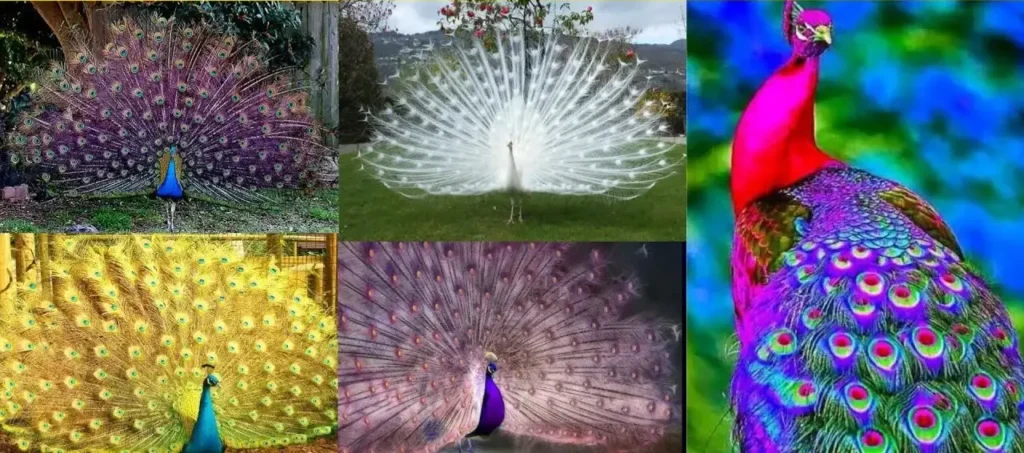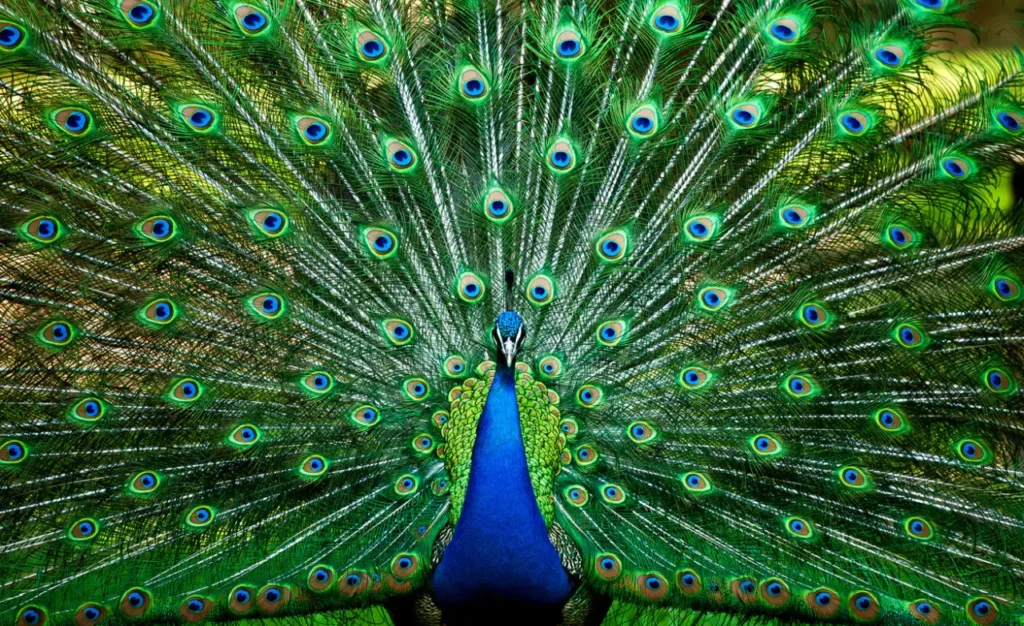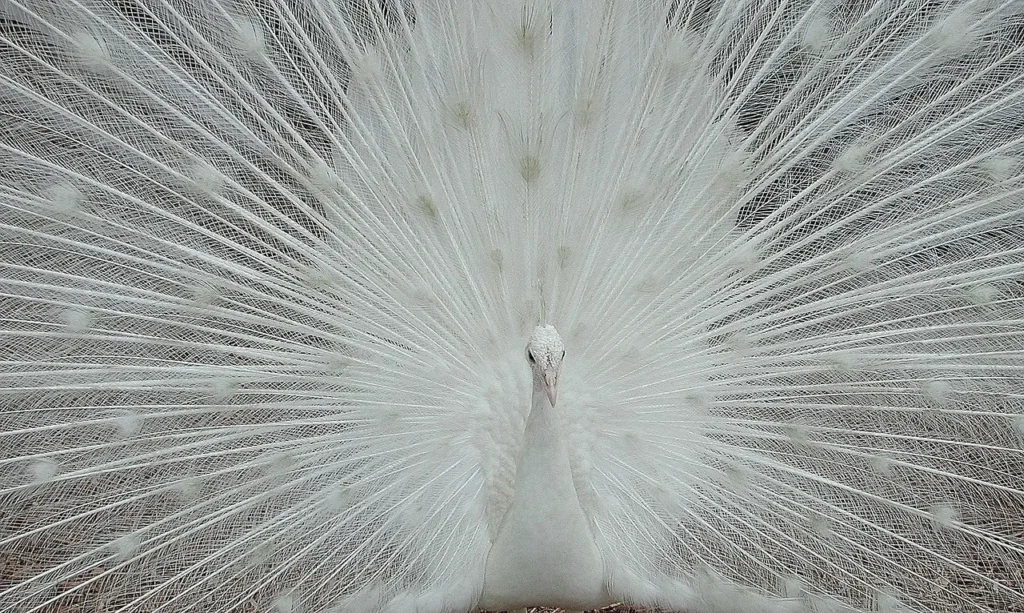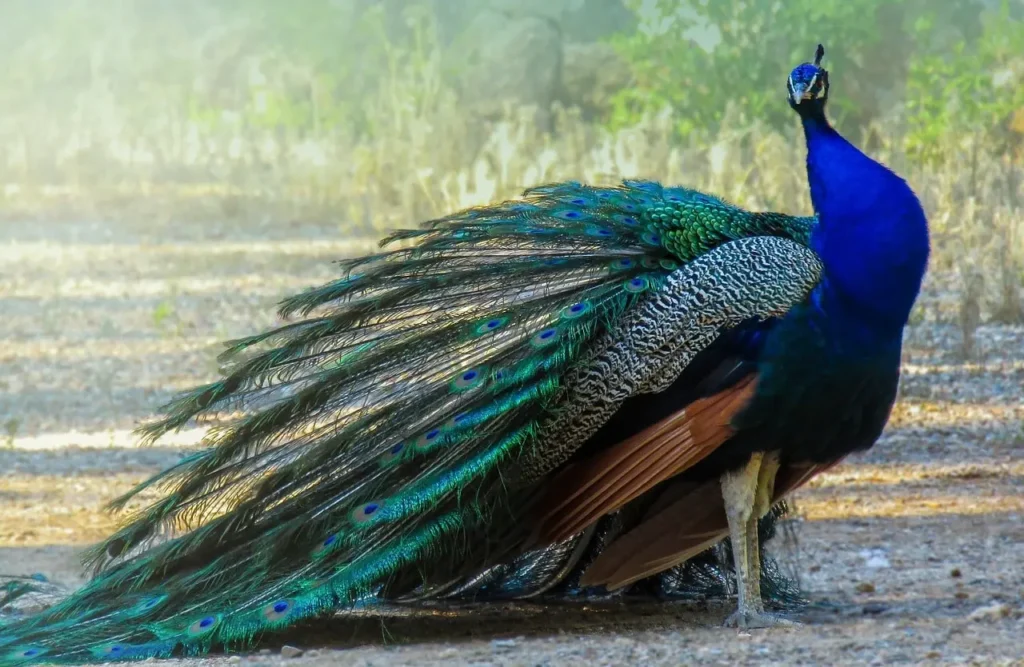Peafowl, also known as peacocks and peahens, are large and strikingly beautiful birds known for their impressive plumage and distinct calls. They belong to the family Phasianidae, which includes pheasants, quails, and other game birds. Peafowl are native to South Asia, and they have become popular and iconic birds in various parts of the world due to their ornate appearance.

Here’s some information about peafowl:
Species: There are three main species of peafowl:
- Indian Peafowl (Pavo cristatus): This is the most well-known species and is often simply referred to as the “peacock.” The males are known for their large, iridescent, and colorful tail feathers, while the females are called peahens and have more subdued plumage.
- Green Peafowl (Pavo muticus): This species has a slightly smaller size than Indian peafowl and is native to Southeast Asia. Males have striking green and metallic blue plumage, and females have a similar but less vibrant appearance.
- Congo Peafowl (Afropavo congensis): This species is native to the dense rainforests of central Africa. Males have metallic blue and green plumage with a distinctive crest, while females are brown and relatively dull in comparison.
Physical Characteristics:
- Males (Peacocks): Male peafowl are known for their incredibly long and colorful tail feathers, which are used in elaborate courtship displays to attract females. These feathers are actually called “trains” and can be as long as 5 feet (1.5 meters) in Indian peafowl.
- Females (Peahens): Female peafowl have more muted plumage, which serves as camouflage to help them blend into their surroundings while nesting and rearing young.
Behavior and Habitat:
- Peafowl are typically found in forests, woodlands, and grasslands. They are adaptable birds that can thrive in a variety of environments.
- Males are known for their elaborate courtship displays, during which they fan out their tail feathers, raise their crest, and strut around while emitting loud calls. This display is intended to attract females.
- They are omnivores, feeding on a diet that includes grains, insects, fruits, and vegetation.
Cultural Significance:
- Peafowl have held cultural significance in various societies throughout history. They are often associated with beauty, royalty, and spirituality.
- In many cultures, the peacock’s magnificent plumage has been considered a symbol of wealth, elegance, and divine beauty.
Domestication and Captive Care:
- Peafowl are sometimes kept in captivity for their ornamental value. They are often found in zoos, parks, and private estates.
- Keeping peafowl requires suitable enclosures, proper diet, and attention to their specific care needs.
- Peafowl are known for their loud calls, especially during the breeding season, which can be a consideration for those living in residential areas.
Conservation Status:
- While Indian peafowl are not considered threatened, both the green peafowl and Congo peafowl have faced habitat loss and degradation, contributing to their decline in the wild. These species are listed as vulnerable and near threatened, respectively, by the International Union for Conservation of Nature (IUCN).
Overall, peafowl are iconic birds with striking appearances and fascinating behaviors. Their stunning plumage and unique courtship displays make them a remarkable and memorable species in the avian world.




Types of peacock
There is one main species of peafowl, which is the peacock, but it comes in various subspecies and color variations. Here are the main types of peafowl:
- Indian Peafowl (Pavo cristatus): The Indian Peafowl, also known as the Common Peafowl or simply peacock, is the most well-known and widespread species. It’s native to the Indian subcontinent and has been introduced to many other parts of the world due to its striking appearance.
- Indian Blue Peafowl: This is the most recognizable type of peafowl. The males, known as peacocks, are known for their iridescent blue-green plumage, striking “eyespots” on their tail feathers, and a distinctive “train” of long feathers that are displayed during courtship.
- White Peafowl: White peafowl are a color variation of the Indian Blue Peafowl. They have white plumage, and their train feathers are also white. They are the same species as the Indian Blue Peafowl but have a different color genetic mutation.
- Black-shouldered Peafowl: This is a color variant of the Indian Blue Peafowl where the males have a reduced amount of the typical blue and green coloration, with more muted shades on their upper bodies. Their shoulder feathers are black.
- Green Peafowl (Pavo muticus): The Green Peafowl is native to Southeast Asia and is characterized by its deep green and metallic bronze plumage. It has a longer and more slender body compared to the Indian Peafowl. The males, known as peacocks, have a similarly impressive train, though it is often shorter than that of the Indian Peafowl. The Green Peafowl is considered vulnerable due to habitat loss and hunting.
- Indochinese Green Peafowl: This is the most widespread subspecies of Green Peafowl, found in Southeast Asia.
- Burmese Green Peafowl: This subspecies is found in Myanmar and has more distinct metallic coloring.
- Javanese Green Peafowl: This subspecies is found on the island of Java in Indonesia.
- Java Peafowl (Pavo muticus muticus): This subspecies of Green Peafowl is native to the island of Java in Indonesia. It’s smaller than the Indochinese Green Peafowl and has distinct features, including a smaller and more ornate train in males.
- Bali Peafowl (Pavo muticus muticus): Also a subspecies of the Green Peafowl, the Bali Peafowl is native to the island of Bali in Indonesia. It’s critically endangered and has distinctive blue and green plumage.
- Cameo Peafowl: This is a rare and sought-after color variation of the Indian Blue Peafowl. Cameo peafowl have a pale, peachy coloration instead of the typical blue and green.
- Purple Peafowl: This is another color variant of the Indian Blue Peafowl, where the blue and green colors are replaced with shades of purple and lavender.
- Opal Peafowl: Opal peafowl are known for their unique pastel and iridescent colors, which include soft blues, greens, and pinks. They are not a distinct subspecies but rather a result of selective breeding for specific color patterns.
- Buford Bronze Peafowl: This is a color variant of the Indian Blue Peafowl that has rich and warm bronze tones in its plumage.
- White-eyed Peafowl: This color variant of the Indian Blue Peafowl has white feathers on the upper parts of its wings, creating a distinct white eye-like pattern.
- Pied Peafowl: Pied peafowl have irregular patches of white or pale feathers mixed with their usual colors. This variation can occur in both Indian Blue and Green Peafowl.
- Oaten Peafowl: This color variant of the Indian Blue Peafowl has muted and earthy tones, resembling the color of oats.
- Buff Peafowl: Buff peafowl have lighter and warmer coloration compared to the typical Indian Blue Peafowl.
- Purple Pied Peafowl: This is a combination of the pied variation and the purple coloration. It features patches of purple and lavender among the white and typical peacock colors.
- Midnight Peafowl: Midnight peafowl are characterized by their dark, almost black plumage. This striking color variation is the result of selective breeding.
- Charcoal Peafowl: Charcoal peafowl have deep gray or charcoal-colored plumage. They are known for their rich and smoky appearance.
- Emerald Spalding Peafowl: This is a hybrid peafowl resulting from the crossbreeding of Indian Blue and Green Peafowl. They often have vibrant and iridescent green and blue plumage.
- White Java Peafowl: This is a white color variation of the Java Peafowl, which is a subspecies of the Green Peafowl.
- White Indian Peafowl: White Indian peafowl are a color variant of the Indian Blue Peafowl with entirely white plumage. They often retain the same eye-catching train display.
- Cinnamon Peafowl: Cinnamon peafowl have warm, cinnamon-brown plumage. They can exhibit a range of cinnamon tones.
- Taupe Peafowl: Taupe peafowl have neutral and earthy tones, often resembling shades of taupe, beige, and gray.
- Bronze Pied Peafowl: This variation combines the pied pattern with bronze coloring, resulting in a distinctive and visually appealing appearance.
- Peach Peafowl: Peach peafowl have soft and delicate shades of peach and pink in their plumage.
- Silver Pied Peafowl: Similar to the bronze pied variation, the silver pied peafowl has white patches mixed with silver or gray colors.
- Violet Peafowl: This variation has plumage with shades of violet and purple, creating a unique and mesmerizing effect.
- Albino Peafowl: Albino peafowl have a genetic condition that results in a complete lack of pigmentation. They have white feathers and pinkish eyes.
- Cream Peafowl: Cream peafowl have pale and creamy-colored plumage that gives them an elegant appearance.
- Chocolate Peafowl: This variation has rich chocolate-brown plumage that stands out from the traditional peacock colors.
- Leucistic Peafowl: Leucistic peafowl have a condition called leucism, which causes a partial loss of pigmentation. Unlike albinism, their eyes are typically not pink. They can have a mix of white and normal-colored feathers.
- Taupe Pied Peafowl: This variation combines the pied pattern with taupe or grayish coloring, creating a striking contrast.
- Silver White-Eyed Peafowl: A variation of the white peafowl, the silver white-eyed peafowl has silver plumage with the distinctive white eye patches.
- White Spalding Peafowl: This is a hybrid peafowl resulting from the crossbreeding of Indian Blue and White Peafowl. They have white plumage with occasional blue markings.
- Lavender Pied Peafowl: This variation combines the pied pattern with soft lavender coloring, resulting in a lovely and unique appearance.
- Peach Pied Peafowl: The pied pattern combined with soft peach-colored plumage creates a visually appealing contrast.
- Powder Blue Peafowl: This variation features pale blue plumage that resembles the color of powdered blue.
- Red-Shouldered Peafowl: In this variation, the shoulder feathers of the peacock are a reddish color, adding a splash of warmth to the plumage.
- Platinum Pied Peafowl: The pied pattern combined with platinum or silvery-white coloring creates a distinctive and elegant look.
- Apricot Peafowl: Apricot peafowl have soft and warm apricot-colored plumage, reminiscent of the fruit.
- Sunset Peafowl: This variation features a blend of warm sunset-like colors, such as red, orange, and gold.
- Topaz Peafowl: Topaz peafowl have a shade of yellow that resembles the gemstone topaz.
- Rainbow Peafowl: A playful term used to describe peafowl with a wide range of vibrant and colorful plumage.
- Mirror Peafowl: This term is used to describe a variation where the “eyespots” on the peacock’s train are particularly symmetrical and well-defined.
- Starburst Peafowl: Similar to the mirror variation, the starburst peafowl has distinct markings that resemble a starburst pattern.
- Bronze Sapphire Peafowl: This variation combines rich bronze and deep blue colors, creating a stunning contrast.
- Lavender Spalding Peafowl: A hybrid between Indian Blue and Lavender Peafowl, Lavender Spalding peafowl have lavender plumage with occasional blue markings.
- Ruby Peafowl: This variation features vibrant red or ruby-colored plumage.
- Sunrise Peafowl: A color pattern resembling the warm and vibrant colors of a sunrise, including shades of red, orange, and yellow.
- Mocha Peafowl: This variation has rich, chocolate-brown plumage, reminiscent of the color of mocha.
- Rainbow Pied Peafowl: A combination of the pied pattern and a range of vibrant colors, resembling a rainbow.
- Azure Peafowl: Azure peafowl have bright and vivid blue plumage, reminiscent of the azure sky.
- Teal Peafowl: Teal peafowl have plumage in shades of greenish-blue, resembling the color of teal.
- Citrine Peafowl: Citrine peafowl have plumage in shades of yellow or citrine, reminiscent of the gemstone.
- Sunflower Peafowl: This variation features sunny yellow plumage, like the petals of a sunflower.
- Rainforest Peafowl: A vibrant combination of green, blue, and other tropical colors, resembling the diverse hues of a rainforest.
- Galactic Peafowl: A playful term used to describe peafowl with plumage patterns that resemble stars, galaxies, or outer space.
- Harlequin Peafowl: Harlequin peafowl have a patchwork of various colors and patterns, creating a visually striking and unique appearance.
- Ink Peafowl: This variation features deep, inky-black plumage that is exceptionally dark and rich.
- Watercolor Peafowl: A variation with pastel and blended colors that resemble the soft and delicate hues of a watercolor painting.
- Velvet Peafowl: Velvet peafowl have plumage that appears rich and velvety, with deep and dark colors.
- Firework Peafowl: A playful term used to describe peafowl with patterns that resemble the burst of colors in a firework display.
There is also a closely related bird known as the Congo Peafowl (Afropavo congensis), which is native to the forests of central Africa. It is significantly smaller than the Indian and Green Peafowls and has a unique appearance, with a blue body and a distinctive crest of feathers on its head.

It’s important to note that the term “peafowl” is used to refer to the bird species as a whole, while “peacock” refers specifically to the males with the colorful plumage. Females are known as peahens, and both genders are collectively known as peafowl.








